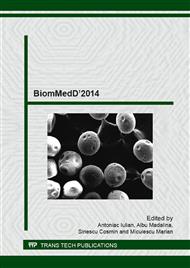p.98
p.104
p.111
p.117
p.123
p.130
p.135
p.141
p.145
A Three-Dimensional Finite Element Analysis of Restored Deciduous Canine
Abstract:
The literature reports that dental cavities are an international public health challenge and treatment of decays especially for young children is a medical problem of great importance. Early childhood caries progress rapidly and can cause functional, physical and dentofacial aesthetic impairment. Recent studies show that caries lesions can compromise children’s quality of life due to the pain and discomfort which could lead to disfigurement, acute and chronic infections and to alteration of meals and sleeping habits. Tooth decay occurs when acids in the mouth dissolve the outer layers of the tooth, stripping the tooth of important minerals. Because dental decay often goes untreated, the cavity grows and more tooth structure is lost. Restorative dentistry has the main purpose of rehabilitating the function and aesthetic of tooth. The structural integrity of the restored teeth depends on the state of stress in their different regions due to occlusal loads. The aim of this study performed with the finite element method is to evaluate the stress and strain distributions in bone structure-primary canine-restorative material assembly when a load of 120N is applied all over the upper surface of the model. Particular attention was given to an accurate computer reconstruction of the canine. Therefore with the aid of a CT scanner the tomography images obtained were processed with a special software (Mimics). Two dental restorative materials, commonly used in practice were chosen for the analysis and the results acquired are compared. Also the contact pressure at the interface bone-deciduous canine and deciduous canine-dental material is evaluated in both cases.
Info:
Periodical:
Pages:
123-129
Citation:
Online since:
March 2015
Authors:
Keywords:
Price:
Сopyright:
© 2015 Trans Tech Publications Ltd. All Rights Reserved
Share:
Citation:


